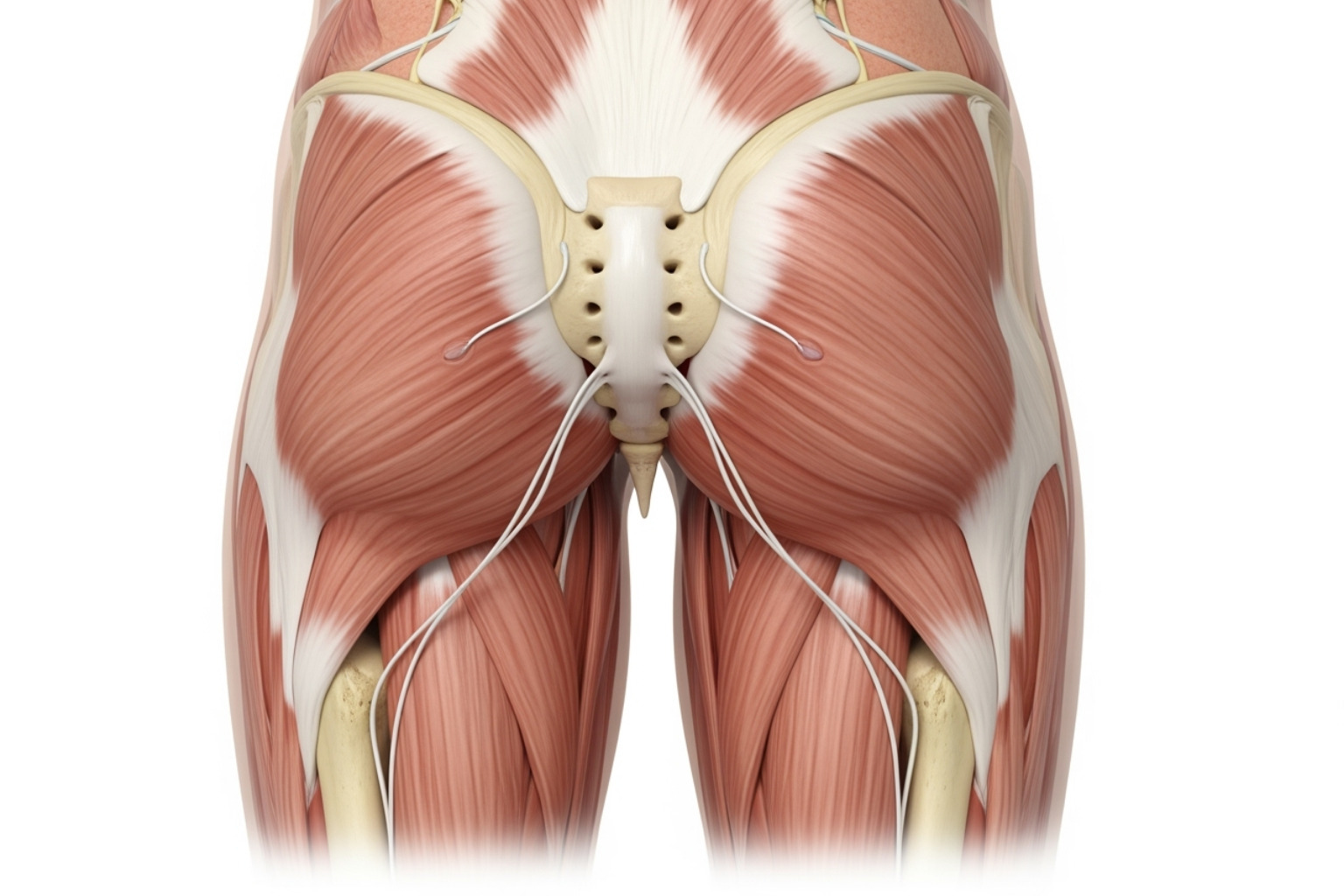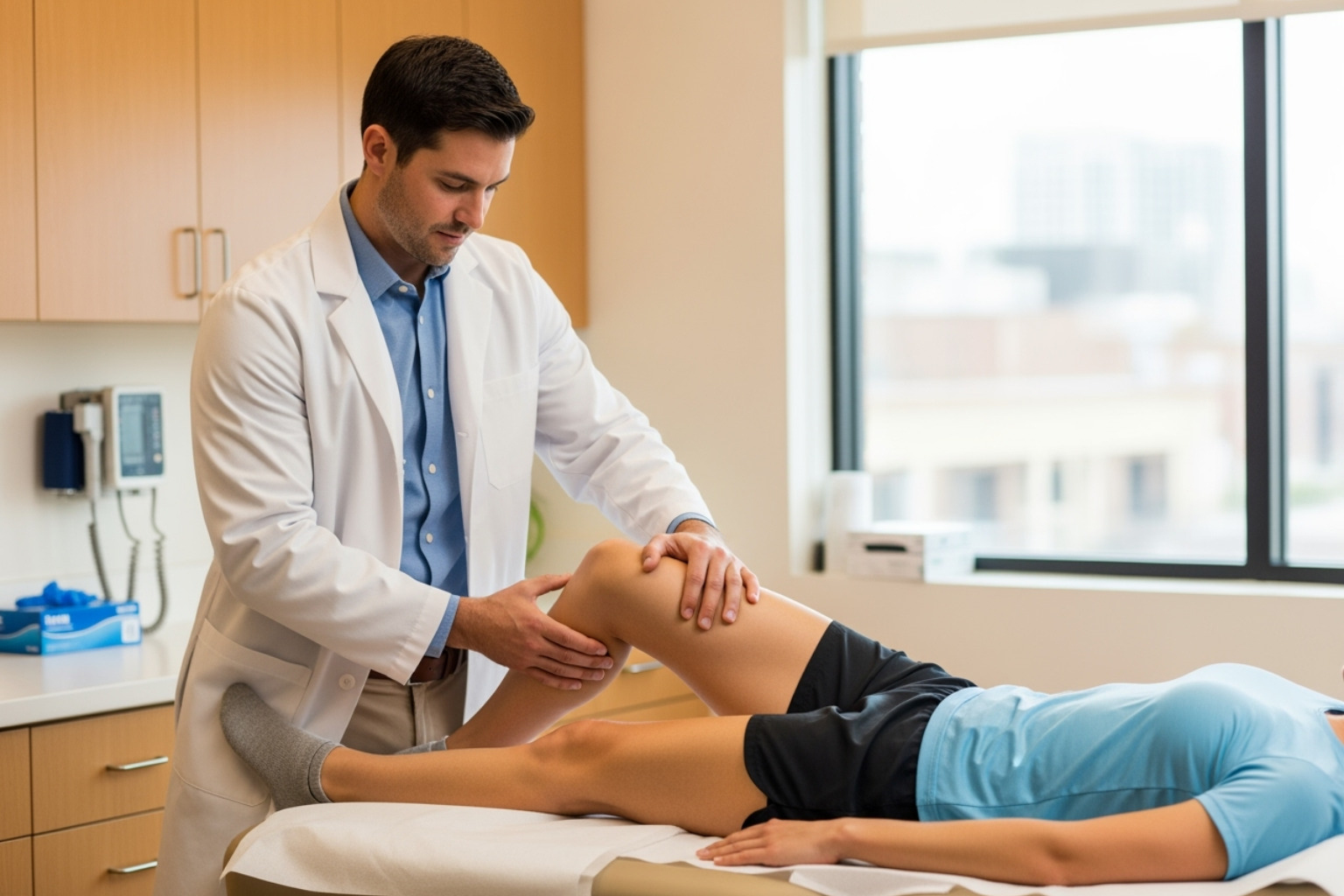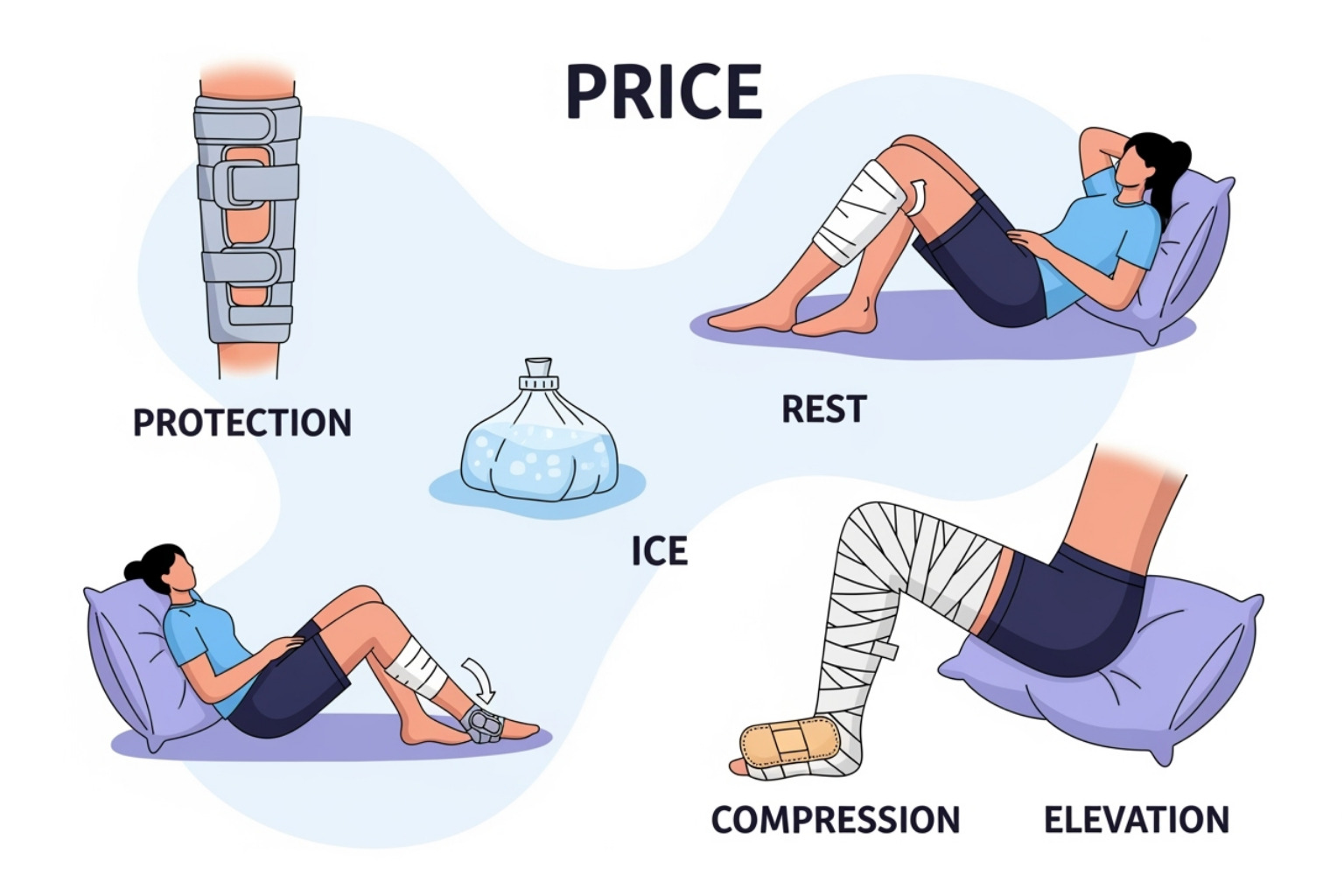Why Understanding Hamstring Muscle Strains Matters for Your Recovery
A hamstring muscle strain is one of the most common sports injuries, affecting athletes and active individuals alike. Whether it's a sudden "pop" during a sprint or gradual tightness, proper treatment is key to avoiding recurring problems. In fact, research shows that almost one in three hamstring strains recur, often within two weeks of returning to sport, highlighting the need for complete healing.
Quick Treatment Overview:
- Immediate Care - Apply the PRICE protocol (Protection, Rest, Ice, Compression, Elevation) within the first 48-72 hours.
- Severity Assessment - Grade 1 (mild) heals in 1-3 weeks, Grade 2 (moderate) in 4-8 weeks, and Grade 3 (severe) in 3-6 months.
- Professional Help - See a doctor if you can't bear weight, have severe pain, or heard a "pop."
- Rehabilitation - Follow a physical therapy program with gentle stretching, strengthening, and eccentric exercises.
- Prevention - Use regular warm-ups, eccentric training (like Nordic curls), and balanced muscle strengthening to reduce re-injury risk.
I'm Tony Enrico, and my work helping people manage muscle and nerve pain has shown me how disruptive a hamstring muscle strain can be. My mission with Neuropasil is to provide effective, natural relief to support recovery and help people return to the activities they love.

Understanding Hamstring Injuries: Anatomy, Grades, and Symptoms
Your hamstrings are a group of three muscles on the back of your thigh: the semitendinosus, semimembranosus, and biceps femoris. They run from your "sit bone" (ischial tuberosity) to just below your knee.

These muscles power daily movements like walking, running, and jumping by bending your knee (knee flexion) and straightening your hip (hip extension). A hamstring muscle strain occurs when these muscles or their tendons are overstretched or torn. A "strain" and a "tear" describe different degrees of the same injury.
What are the Different Grades of Hamstring Injuries?
Healthcare providers use a grading system, as detailed by medical authorities like the Mayo Clinic, to classify hamstring muscle strains based on the extent of muscle fiber damage. This helps estimate your recovery timeline and determine the best treatment.
| Grade of Hamstring Strain | Description | Severity of Damage | Pain Level | Loss of Function |
|---|---|---|---|---|
| Grade 1 | Mild muscle strain or "pull" | Microscopic tears in a few muscle fibers | Mild discomfort, tightness | Minimal; may feel stiff but can walk |
| Grade 2 | Moderate muscle strain or partial tear | Significant tearing of muscle fibers, but not complete | Moderate to severe pain, sharp | Noticeable weakness, limping, difficulty with full range of motion |
| Grade 3 | Severe muscle strain or complete tear/rupture | Complete rupture of the muscle or tendon | Intense, immediate, debilitating pain | Inability to bear weight, severe weakness, significant bruising, audible "pop" |
- Grade 1 (Mild Strain): Involves microscopic tears. You'll feel tightness but have no significant loss of strength and can still walk.
- Grade 2 (Partial Tear): A significant number of fibers are torn. Pain is moderate to sharp, with swelling and tenderness. Walking is difficult and causes a limp.
- Grade 3 (Complete Tear): The muscle or tendon ruptures completely. This causes intense, immediate pain, often with an audible "pop." You will be unable to bear weight, and significant bruising and swelling will appear. A gap may be felt in the muscle.
Common Symptoms of a Hamstring Injury
Recognizing the signs of a hamstring muscle strain early is crucial. While intensity varies by grade, watch for these common symptoms:
- Sudden sharp pain in the back of the thigh during activity.
- A popping sensation or sound at the time of injury.
- Swelling that appears quickly as the body's inflammatory response begins.
- Bruising (ecchymosis) that develops along the back of the thigh, sometimes spreading toward the knee.
- Tenderness to the touch.
- Muscle weakness, making it hard to bend your knee.
- Inability to bear weight on the injured leg, especially with Grade 2 or 3 strains.
- Muscle stiffness and spasms, particularly in the days following the injury.
Causes, Risk Factors, and Diagnosis of a Hamstring Muscle Strain
Understanding why a hamstring muscle strain occurs is the first step toward prevention. Injuries typically happen in one of two ways, as classified in sports medicine research:
- Type I (High-Speed Running): Occurs during sprinting when the hamstring contracts eccentrically (lengthens while under tension) to slow the lower leg. The biceps femoris muscle is most commonly affected.
- Type II (Stretching): Happens when the hamstring is stretched beyond its limit, such as during a high kick or split. The semimembranosus muscle is often involved.
Several risk factors increase your vulnerability:
- Muscle Overload & Fatigue: Pushing tired muscles too hard reduces their ability to absorb shock.
- Muscle Imbalances: If your quadriceps are much stronger than your hamstrings, it can create excessive strain. Weak glutes also force hamstrings to overcompensate.
- Poor Flexibility: Tight muscles are more prone to tearing during dynamic movements.
- Previous Hamstring Injury: This is the biggest risk factor, with a prior strain being the most common predictor of a future one. Re-injury is common, especially if rehabilitation was incomplete.
- Other Factors: Inadequate warm-ups, age (both older athletes and adolescents), and being deconditioned at the start of a sports season increase risk.
How is a Hamstring Injury Diagnosed?
An accurate diagnosis is key to proper healing. A healthcare provider can often diagnose a hamstring muscle strain with a clinical assessment.

- Patient History: Your doctor will ask how the injury occurred, the location of the pain, and if you heard a "pop."
- Physical Examination: The provider will look for swelling and bruising, then gently palpate (feel) the muscle to locate tenderness and check for any gaps indicating a rupture.
- Range of Motion & Strength Testing: Your ability to move your leg (both actively and passively) and push against resistance will be tested to evaluate function and pain levels.
- Imaging Tests: For severe injuries or unclear diagnoses, imaging may be used. MRI is the gold standard for viewing soft tissue damage, showing the location and extent of a tear. Ultrasound is another effective tool for visualizing tears and monitoring healing. An X-ray may be ordered to rule out an avulsion injury, where the tendon pulls a piece of bone away.
When to Seek Professional Medical Help
While mild strains can be managed at home, certain signs indicate you need to see a professional. Seek medical help if you experience:
- Severe, unbearable pain that doesn't improve with home care.
- Inability to walk more than a few steps without significant pain.
- Rapid or extensive swelling and bruising.
- A distinct "pop" sound or sensation at the time of injury.
- A noticeable gap or deformity in the muscle.
- Symptoms that persist or worsen after several days of self-care.
If you're unsure, resources like NHS 111 online can help guide your next steps. It's always better to be cautious and get a proper diagnosis.
A Phased Approach to Hamstring Strain Treatment and Recovery
Recovering from a hamstring muscle strain requires a phased approach that respects your body's healing process. Rushing recovery is a primary cause of re-injury. The goal is to restore full strength, flexibility, and function, not just to eliminate pain.
Immediate First Aid: The PRICE Protocol
In the first 48-72 hours, managing inflammation is critical. Use the PRICE protocol for mild to moderate strains.

- Protection: Stop the activity and shield the muscle from further harm. Use crutches if necessary.
- Rest: Avoid activities that stress the hamstring. Gentle, pain-free movement is better than complete immobilization after the initial phase.
- Ice: Apply an ice pack wrapped in a towel for 15-20 minutes every 2-3 hours to reduce pain and swelling.
- Compression: Use an elastic bandage to limit swelling, but don't wrap it so tightly that it causes numbness or tingling.
- Elevation: Prop your leg above heart level to help drain fluid from the injury site.
Also, remember the No HARM rule for the first 72 hours: No Heat, Alcohol, Running, or Massage, as these can increase swelling and slow healing.
The Role of Physical Therapy in Hamstring Muscle Strain Recovery
After the acute phase, physical therapy is your roadmap to full recovery, especially for Grade 2 and 3 injuries. A therapist will create a personalized program to help you heal and prevent recurrence.
- Gentle Stretching: Once inflammation subsides, pain-free stretches will be introduced to restore muscle length.
- Strengthening Exercises: You'll progress from isometric (tensing without moving) to isotonic (moving against resistance) exercises.
- Eccentric Exercises: This is the secret weapon. Strengthening the muscle while it lengthens (e.g., Nordic hamstring curls) is proven to dramatically reduce re-injury rates.
- Core Stability & Proprioception: A strong core provides a stable base for leg movements, while balance and agility drills retrain your body's sense of position and movement.
Your therapist will monitor your progress to ensure you're ready for each new phase. For tips on managing discomfort during this process, see More info about managing muscle pain.
Typical Recovery Time for a Hamstring Muscle Strain
Recovery time depends on the severity of the strain and your adherence to rehabilitation.
- Grade 1 (Mild Strain): 1 to 3 weeks. Resist the temptation to return to full activity too soon.
- Grade 2 (Partial Tear): 4 to 8 weeks. A structured physical therapy program is essential.
- Grade 3 (Complete Tear): 3 to 6 months or longer, especially if surgery is required. Post-surgical rehab can take at least 6 months.
Your injury type also matters. High-speed running injuries (Type I) may recover more predictably than overstretch injuries (Type II), which can be more stubborn. Factors like age and location of the tear also influence healing. However, the single biggest factor is following your rehabilitation plan. Rushing back is the main reason nearly 1 in 3 hamstring strains recur.
Prevention and Advanced Therapies for Hamstring Health
Preventing a hamstring muscle strain is far better than treating one. Building resilient, strong hamstrings is an investment in your long-term athletic health.
How to Prevent Hamstring Injuries
Incorporate these strategies to keep your hamstrings healthy and reduce your risk of injury.
- Proper Warm-Up: Always start with light cardio and dynamic movements like leg swings and walking lunges to increase blood flow and prepare muscles for activity.
- Strengthening Program: Focus on strengthening not just your hamstrings, but also your glutes and core, which provide crucial support.
- Eccentric Training: The Nordic hamstring curl is a game-changer. It strengthens the hamstring during its lengthening phase, when it's most vulnerable. Studies show it significantly reduces injury rates.

- Maintain Flexibility: Use static stretches (holding a position) during your cool-down to maintain muscle length and reduce tightness.
- Address Muscle Imbalances: Ensure your hamstrings are not significantly weaker than your quadriceps to prevent overload.
- Progress Gradually: Increase training intensity or volume by no more than 10% per week. Listen to your body and rest when you feel fatigue or pain.
Supporting Recovery and Muscle Comfort
During recovery from a hamstring muscle strain or when dealing with soreness from training, supporting your body's healing process is key.
Topical analgesics can provide targeted relief for muscle soreness and discomfort. Creams containing ingredients like menthol create a cooling sensation that helps distract from pain and soothe aches and stiffness.
While a strain is a muscle injury, nerve irritation can sometimes occur. In these cases, a cream designed for nerve discomfort can be beneficial.
This is where Neuropasil comes in. Our formula was created to address muscle soreness, aches, and nerve discomfort. The blend of Aloe, Urea, and Menthol works to soothe sore muscles and provide fast, natural comfort. Whether you're managing pain from a hamstring muscle strain or general soreness from a tough workout, Neuropasil offers targeted relief to help you feel better, faster.
It's a valuable tool in any recovery kit, making the journey back to full strength more comfortable. If you need an effective, natural solution, we invite you to Find natural relief for sore muscles.
Frequently Asked Questions about Hamstring Strains
Here are concise answers to some of the most common questions about hamstring muscle strain.
How long does a pulled hamstring take to heal?
Healing time depends entirely on the severity (grade) of the injury:
- Grade 1 (Mild): 1 to 3 weeks.
- Grade 2 (Moderate): 4 to 8 weeks.
- Grade 3 (Severe): 3 to 6 months, or longer if surgery is needed.
Proper rehabilitation is crucial, as rushing back is the main cause of re-injury. Feeling better does not mean you are fully healed.
Can I still walk with a hamstring strain?
This depends on the grade of your injury:
- Grade 1 (Mild): Yes, walking is usually possible, though you may feel some stiffness or discomfort.
- Grade 2 (Moderate): Walking will be painful and difficult, likely causing a limp. Crutches are often recommended to protect the muscle.
- Grade 3 (Severe): No, walking is typically impossible due to intense pain. Crutches are necessary.
Let pain be your guide. If an activity hurts, your body is not ready for it.
What is the fastest way to heal a hamstring strain?
There are no shortcuts. The "fastest" way to heal is the most thorough and patient way. Trying to rush the process often leads to setbacks and re-injury.
Effective healing involves:
- Immediate Care: Following the PRICE protocol (Protection, Rest, Ice, Compression, Elevation) in the first 48-72 hours.
- Adhering to Physical Therapy: Committing to a progressive rehabilitation program designed by a professional.
- Gradual Return to Activity: Slowly reintroducing sport-specific movements only when your hamstring is strong enough.
- Avoiding Re-injury: Listening to your body and not returning to strenuous activity before you are fully healed.
Patience is key to a full and lasting recovery.
Conclusion: Your Path to a Full Recovery
Recovering from a hamstring muscle strain is an active process of rebuilding strength and resilience. The journey begins with immediate first aid (PRICE), followed by an accurate diagnosis and a structured physical therapy program. Eccentric exercises like Nordic curls are vital for restoring strength and preventing future problems.
Patience is your greatest asset. Nearly one in three hamstring strains recur, usually from returning to activity too soon. Listening to your body and respecting its healing timeline is wisdom, not weakness. A full recovery means emerging with hamstrings that are stronger and more resilient than before.
Prevention is just as important as treatment. Consistent warm-ups, balanced strengthening, and gradual training progression are your best defense against future injury.
As you steer the later stages of recovery, managing residual soreness is important. For targeted relief of muscle aches and discomfort, a topical analgesic like Neuropasil can help. Our blend of Aloe, Urea, and Menthol is designed to soothe muscles and support your return to the activities you love. Find natural relief for sore muscles.
Trust the process, and you'll not only recover but also build a stronger foundation for your future health and performance.
References
This article draws from trusted medical research and clinical guidelines to provide accurate, evidence-based information on hamstring muscle strains.
Heiderscheit, B. C., Sherry, M. A., Silder, A., Chumanov, E. S., & Thelen, D. G. (2010). Hamstring Strain Injuries: Recommendations for Diagnosis, Rehabilitation, and Injury Prevention. Journal of Orthopaedic & Sports Physical Therapy. This clinical practice guideline is a primary source for the high recurrence rate of hamstring injuries, the importance of previous injury as a risk factor, and the effectiveness of eccentric strengthening exercises. https://www.jospt.org/doi/abs/10.2519/jospt.2010.3047
Chu, S. K., & Rho, M. E. (2016). Hamstring Injuries in the Athlete: Diagnosis, Treatment, and Return to Play. Current Sports Medicine Reports. This review provides key information on the classification of injury types (high-speed vs. stretching), diagnostic methods like MRI, and factors influencing recovery time. https://www.ncbi.nlm.nih.gov/pmc/articles/PMC5003616/
Mayo Clinic. Hamstring injury. A comprehensive patient-facing resource used to source general information on symptoms, causes, and the grading of hamstring strains. https://www.mayoclinic.org/diseases-conditions/hamstring-injury/symptoms-causes/syc-20372985
Cleveland Clinic. Hamstring Injury. An authoritative source for patient information on treatment protocols like PRICE and typical recovery timelines for different grades of injury. https://my.clevelandclinic.org/health/diseases/17039-hamstring-injury














